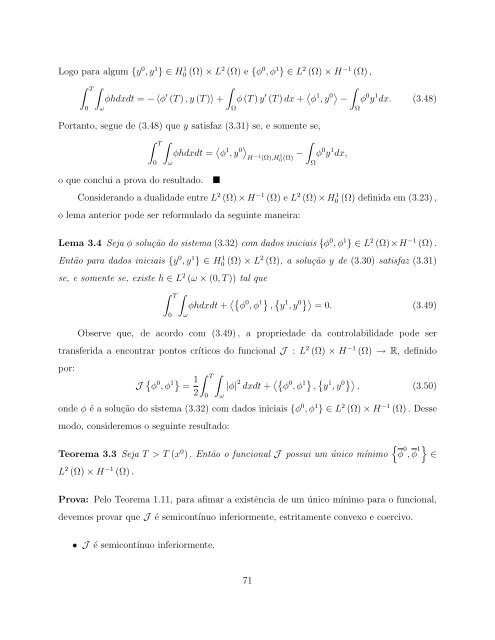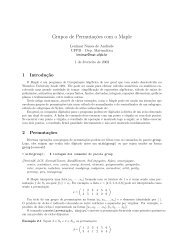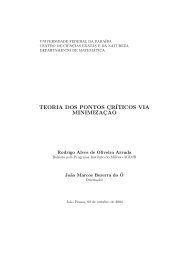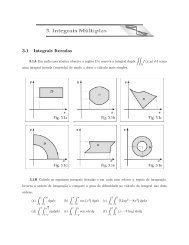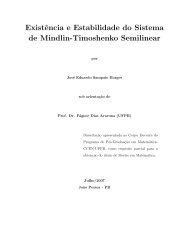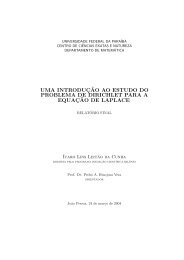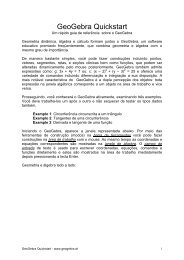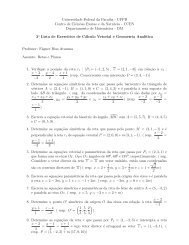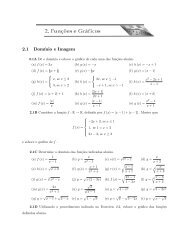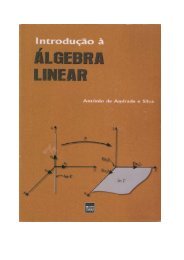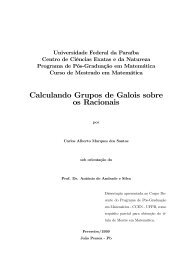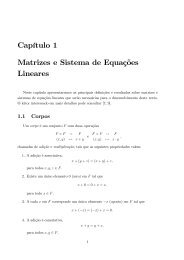Controlabilidade Exata e Aproximada da Equação da Onda Linear
Controlabilidade Exata e Aproximada da Equação da Onda Linear
Controlabilidade Exata e Aproximada da Equação da Onda Linear
You also want an ePaper? Increase the reach of your titles
YUMPU automatically turns print PDFs into web optimized ePapers that Google loves.
Logo para algum {y 0 , y 1 } ∈ H 1 0 (Ω) × L 2 (Ω) e {φ 0 , φ 1 } ∈ L 2 (Ω) × H −1 (Ω) ,<br />
T <br />
φhdxdt = − 〈φ ′ <br />
(T ) , y (T )〉 +<br />
0<br />
ω<br />
Ω<br />
φ (T ) y ′ (T ) dx + φ 1 , y 0 <br />
−<br />
Portanto, segue de (3.48) que y satisfaz (3.31) se, e somente se,<br />
T <br />
o que conclui a prova do resultado. <br />
0<br />
ω<br />
φhdxdt = φ 1 , y 0<br />
H−1 (Ω),H1 <br />
− φ<br />
0 (Ω)<br />
Ω<br />
0 y 1 dx,<br />
φ<br />
Ω<br />
0 y 1 dx. (3.48)<br />
Considerando a duali<strong>da</strong>de entre L 2 (Ω) × H −1 (Ω) e L 2 (Ω) × H 1 0 (Ω) defini<strong>da</strong> em (3.23) ,<br />
o lema anterior pode ser reformulado <strong>da</strong> seguinte maneira:<br />
Lema 3.4 Seja φ solução do sistema (3.32) com <strong>da</strong>dos iniciais {φ 0 , φ 1 } ∈ L 2 (Ω)×H −1 (Ω) .<br />
Então para <strong>da</strong>dos iniciais {y 0 , y 1 } ∈ H 1 0 (Ω) × L 2 (Ω), a solução y de (3.30) satisfaz (3.31)<br />
se, e somente se, existe h ∈ L 2 (ω × (0, T )) tal que<br />
T <br />
φhdxdt + φ 0 , φ 1 , y 1 , y 0 = 0. (3.49)<br />
0<br />
ω<br />
Observe que, de acordo com (3.49) , a proprie<strong>da</strong>de <strong>da</strong> controlabili<strong>da</strong>de pode ser<br />
transferi<strong>da</strong> a encontrar pontos críticos do funcional J : L 2 (Ω) × H −1 (Ω) → R, definido<br />
por:<br />
J φ 0 , φ 1 = 1<br />
T <br />
2<br />
0<br />
ω<br />
|φ| 2 dxdt + φ 0 , φ 1 , y 1 , y 0 , (3.50)<br />
onde φ é a solução do sistema (3.32) com <strong>da</strong>dos iniciais {φ 0 , φ 1 } ∈ L 2 (Ω) × H −1 (Ω) . Desse<br />
modo, consideremos o seguinte resultado:<br />
Teorema 3.3 Seja T > T (x 0 ) . Então o funcional J possui um único mínimo<br />
L 2 (Ω) × H −1 (Ω) .<br />
<br />
φ 0 , φ 1<br />
∈<br />
Prova: Pelo Teorema 1.11, para afimar a existência de um único mínimo para o funcional,<br />
devemos provar que J é semicontínuo inferiormente, estritamente convexo e coercivo.<br />
• J é semicontínuo inferiormente.<br />
71


